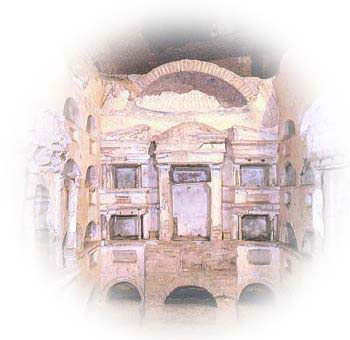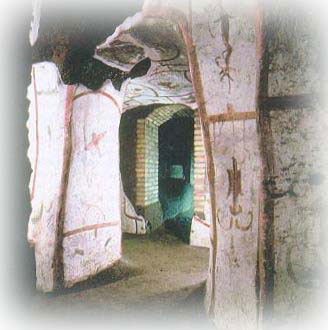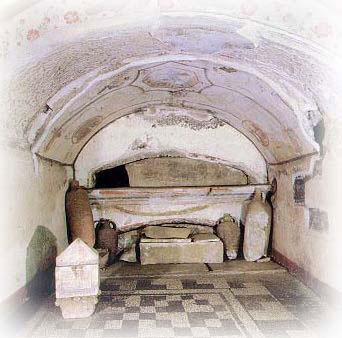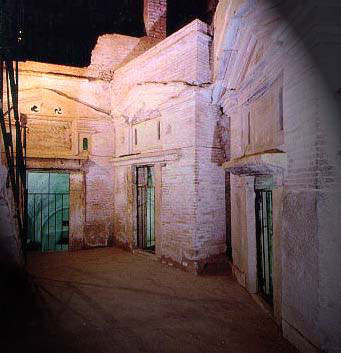| |
 The
catacombs of St. Sebastian are found on the Old Appian Way and are of great
significance for having served as the temporary resting place for the bodies
of the apostles and martyrs Peter and Paul. The site indeed was recalled as
the "Memorial of the Apostles" to celebrate the probable burial of the two
martyrs in the cemetery. In ancient times, the area was called in Greek "ad
catacumbas" to mean "by the hollows"; an indication of the topographical
nature of the region which had always been characterized by its deep
ravines. The uneven terrain had been adopted first as a burial ground in
Imperial times. Inscriptions found during the excavation of the earliest
tombs on the site, for pagan burial, have shown that the cemetery was in use
during Trajan's time (98-117 A.D.). The
catacombs of St. Sebastian are found on the Old Appian Way and are of great
significance for having served as the temporary resting place for the bodies
of the apostles and martyrs Peter and Paul. The site indeed was recalled as
the "Memorial of the Apostles" to celebrate the probable burial of the two
martyrs in the cemetery. In ancient times, the area was called in Greek "ad
catacumbas" to mean "by the hollows"; an indication of the topographical
nature of the region which had always been characterized by its deep
ravines. The uneven terrain had been adopted first as a burial ground in
Imperial times. Inscriptions found during the excavation of the earliest
tombs on the site, for pagan burial, have shown that the cemetery was in use
during Trajan's time (98-117 A.D.).
The site for the catacombs of St.Sebastian had been originally used as a
quarry for pozzolana, or soft volcanic rock. It
was common practise in ancient times for former quarries to become burial
grounds for slaves and freedmen, a place for modest graves, usually no more
than simple loculi or columbarium niches.
Several grand mausolea, however, were also built in this graveyard,
collected together in an area known as the "piazzuola", a relatively large
open space that today is completely buried underground.
Three richly decorated mausolea were built in this space, probably for
wealthy freedmen and their families. The monumental facades all resemble
each other, all with the door at center surmounted by an inscription naming
the proprietor, a tympanum decorated with pictures and attic where probably
the commemorative celebrations were held for the deceased, including the
annual memorial banquet held on the anniversary of his or her death. The
first mausoleum constructed on the site was that of Marcus Clodius Hermes.
The room on the ground floor of the Hermes mausoleum has both arcosolia and
loculi for burial. Below this level is another room with more arcosolia. The
second mausoleum on the piazzuola is called that of the "Innocentiores",
perhaps to indicate the name of an association. In this case, there are no
rooms on the ground floor of the mausoleum, but a steep stairway which leads
to a subterranean burial chamber. The stucco reliefs which cover the vault
of the crypt are particularly noteworthy, including
 representations
of a shell and peacock. The third mausoleum, the last, is known by the image
of an axe in stucco on its facade. This, too, was built with two floors for
burial in arcosolia and loculi. In the tufa walls which form the outer
perimeter of the piazzuola many other loculi were created, destined, most
scholars believe, for pagan burials although in a later phase of burial
activity in the piazzuola, several Christians were also interred there, as
is gathered from the representations of the fish and anchor found which are
typical Christian symbols. Around the middle of the third century, the
topography of the site was drastically altered when the piazzuola was
completely buried under a landfill and a large space was created on this new
upper level. representations
of a shell and peacock. The third mausoleum, the last, is known by the image
of an axe in stucco on its facade. This, too, was built with two floors for
burial in arcosolia and loculi. In the tufa walls which form the outer
perimeter of the piazzuola many other loculi were created, destined, most
scholars believe, for pagan burials although in a later phase of burial
activity in the piazzuola, several Christians were also interred there, as
is gathered from the representations of the fish and anchor found which are
typical Christian symbols. Around the middle of the third century, the
topography of the site was drastically altered when the piazzuola was
completely buried under a landfill and a large space was created on this new
upper level.
This phase was characterized by the creation of a triclia, a covered
space accessed from a small stairway, with the features of an colonnaded
hall furnished with benches attached to its back wall. Other than the
triclia, the space held also a small apsidal monument with a shrine and
niche inside. Although there is no definite proof as to the shrine's
significance, many scholars believe that it was created for, and for a time
held, the remains of the greatest of the apostles and martyrs, Peter and
Paul. The alterations
 on
the site may have been undertaken precisely for this purpose. In addition to
the ancient sources which record the veneration paid to the two apostles at
this site, the "Memorial to the Apostles", numerous scratchings in the
plaster of the back wall of the triclia, to all effects ancient graffiti,
have been found to be invocations and prayers made by the faithful to Peter
and Paul. These testimonials strongly suggest that there was an active cult
of the two saints in the area. Several examples are still legible and are
interesting for what they reveal; for example, the petition of a certain
Victor, who at some point during the third century wrote "Paul and Peter,
pray for Victor", requesting the intercession from two of the most
celebrated martyrs for the Christian faith. The remains of the two saints
would have been translated to the site of the Saint Sebastian catacombs by
the year A.D. 256, out of fear that during the persecution of the Emperor
Valerian the apostles's tombs would be violated and their remains destroyed. on
the site may have been undertaken precisely for this purpose. In addition to
the ancient sources which record the veneration paid to the two apostles at
this site, the "Memorial to the Apostles", numerous scratchings in the
plaster of the back wall of the triclia, to all effects ancient graffiti,
have been found to be invocations and prayers made by the faithful to Peter
and Paul. These testimonials strongly suggest that there was an active cult
of the two saints in the area. Several examples are still legible and are
interesting for what they reveal; for example, the petition of a certain
Victor, who at some point during the third century wrote "Paul and Peter,
pray for Victor", requesting the intercession from two of the most
celebrated martyrs for the Christian faith. The remains of the two saints
would have been translated to the site of the Saint Sebastian catacombs by
the year A.D. 256, out of fear that during the persecution of the Emperor
Valerian the apostles's tombs would be violated and their remains destroyed.
Only in a later and more secure period could they be returned to the
cemeteries on the via Ostiense and Vatican hill. Some doubts about these
events remain, however, for although the evidence for a cult of Peter and
Paul is strong at the Saint Sebastian site, there may never have been in
fact the actual remains of the apostles at that particular cult shrine. The
evidence continues to be hotly debated in scholarly circles. It must also be
noted that during the period when the cult of the apostles was active on the
site, the area was not in use for new burials and therefore would have been
used only for commemorations of the martyrs enshrined there. Finally, during
the fourth century, the shrine and hall were in turn buried under the
foundation of the new Constantinian basilica "of the apostles".

|
